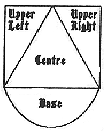
These rules are designed to recreate, in a simple fashion, the jousting tournaments of the Age of Chivalry.
A joust consists of a number of passes, which continues until one knight reaches or surpasses a score of 5. He is then declared the winner. A series of jousts can be set up, with each victory recorded, and the knight with the most victories at the end of the day becomes 'Lord of the Faire.'
Diagram 1 represents a shield, giving the possible aiming points for the attacking knight.

To resolve a jousting pass, both knights secretly select an aiming point and a defensive posture from the Joust Matrix. If figures are being used, they are now brought together as if charging, and passing one another.
The aim points and defensive postures are revealed simultaneously, and the Joust Matrix is cross indexed to determine initial combat modifiers. Each knight rolls a d6, adds and subtracts the appropriate modifiers, and applies the result to the Joust Results Table.
Joust Matrix
| Shield Aiming Point | ||||
|---|---|---|---|---|
| Defensive Posture | Upper Left | Upper Right | Centre | Base |
| Lean Left | -3 | +3 | -1 | +1 |
| Lean Right | +3 | -3 | -1 | +1 |
| Lean Forward | -1 | -1 | +3 | -1 |
| Ride Steady | -1 | -1 | +1 | +1 |
-
+1 if greatly more experienced than opponent
+1 if opponent is less heavily armored than usual
-1 if opponent is more heavily armored than usual
+1 if opponent is injured
Joust Results Table
-
0 Miss
1-3 Glancing Blow
4-5 Break lance on opponent
6+ Unhorse opponent (injury)
Injuries
-
1-3 Slight injury, able to continue
4-5 Serious injury, cannot continue
6 Killed
Scoring
-
+1 Break lance on opponent
+5 Unhorsed opponent
